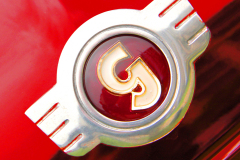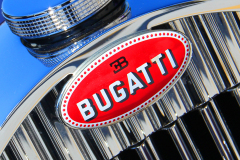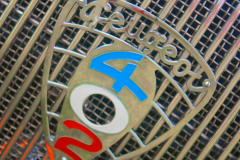Bugatti | Peugot | Goggomobil
Peugeot SA is a French automotive manufacturer, founded in 1896 by Armand Peugeot – it is now part of Groupe PSA.
Peugeot became the first manufacturer to fit rubber tyres (solid, rather than pneumatic) to a petrol-powered car.
Peugeot was an early pioneer in motor racing, winning the world’s first motor race, the Paris–Rouen, in a 3 hp Peugeot. Three Peugeots were entered in the Paris–Bordeaux–Paris race in 1895, marking the debut of Michelin pneumatic tyres in racing – they proved insufficiently durable. These early vehicles were still very much horseless carriages in appearance and were steered by a tiller.
The Peugeot family business was founded in 1810 in Sochaux, France. Originally manufacturing coffee, pepper, and salt grinders – later expanding to steel rods, umbrella frames, saw blades, chisels, wire wheels, and bicycles.. The company’s logo, initially a lion walking on an arrow, symbolized the speed, strength and flexibility of the Peugeot saw blades.
Peugeot has received many international awards for its vehicles, including five European Car of the Year awards. Peugeot is known as a very reliable brand, citing how its 1950s and 1960s models are still running in Africa and Cuba, where Peugeot is called “The Lion”
At the 1901 Paris Salon, Peugeot debuted a tiny shaft-driven 652 cc, 5 hp one-cylinder, dubbed “Bébé” (“baby”), and shed its conservative image, becoming a style leader.
By 1903, Peugeot produced half of the cars built in France, and they offered the 5 hp Bébé, a 6.5 hp four-seater, and an 8 hp and 12 hp resembling contemporary Mercedes models.
1907 saw Peugeot’s first six-cylinder, and by 1910, Peugeot’s product line included a 1,149 cc two-cylinder and six four-cylinders, of between two and six liters.
A more famous name, Ettore Bugatti, designed the new 850 cc, four-cylinder Bébé of 1912.
Automobiles Ettore Bugatti was a French car manufacturer of high-performance automobiles, founded in 1909 in the then German city of Molsheim, Alsace. The Italian-born industrial designer Ettore Bugatti was from a family of artists. The cars were known for their design, beauty and for their many race victories.
Famous Bugattis include the Type 35 Grand Prix cars, the Type 41 “Royale”, the Type 57 “Atlantic” and the Type 55 sports car.
Bugattis also enjoyed great success in early motor racing, winning the first ever Monaco Grand Prix in 1929 and the 24 Hours of Le Mans twice (in 1937 and 1939). The little Bugatti Type 10 swept the top four positions at its first race and the 1924 Bugatti Type 35 is probably the most successful racing car of all time, with over 2,000 wins.
Ettore Bugatti famously described his arch competitor Bentley’s cars as “the world’s fastest lorries” for focusing on durability. According to Bugatti, “weight was the enemy”.
The death of the founder in 1947 proved to be the end for the marque and Bugatti ceased production in the early 1950s. No more than about 8,000 cars were ever made.
Italian entrepreneur Romano Artioli acquired the Bugatti brand in 1987, forming Bugatti Automobili S.p.A.. He also acquired Lotus Cars in 1993 The Bugatti EB 110 is a mid-engine sports car produced from 1991 to 1995, advertised as the most technically advanced sports car ever produced.
By the time it came to market, poor world economic conditions forced the company to cease operations . It was the only production model made by this Italian incarnation of Bugatti.
Volkswagen purchased the Bugatti trademark in June 1998 and incorporated Bugatti Automobiles S.A.S. in 1999.
Goggomobil was a series of microcars produced by Hans Glas GmbH in the Bavarian town Dingolfing between 1955 and 1969. Glas produced three models the T sedan, the TS coupé, and the TL van.
The engine was an air-cooled, two-stroke, two-cylinder unit originally displacing 250 cc, but later available in increased sizes of 300 cc and 400 cc. It had an electric pre-selective transmission built by Getrag and a manual clutch. The engine was behind the rear wheels. Suspension was independent all round using coil springs with swing axles



